

These common reef sharks look similar to the grey reef sharks, but with a conspicuous black tip on their foresail fins. They are considerably smaller than grey reef sharks.
- Max Size: 1.8 m (6 ft); 24 kg (53 lb)
- Diet: Mostly reef fishes. Also includes crustaceans, squid and octopus.
- Conservation Status: Near Threatened (low risk)
- Major Threats to Survival: They are a common catch for commercial fisheries and shark fin trade. A small litter size and long gestation (8-9 months) makes them vulnerable to overfishing.
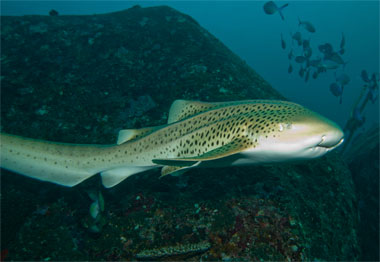
There is no mistaking the zebra sharks with their long broad tails and prominent body ridges. Their name is derived from the striped pattern of juveniles that gradually fades into the spots of the adult. This change in coloration has also earned them the name Leopard Sharks in Australia. Zebra sharks do not need to continuously swim to breath. Instead, they are often seen resting on the bottom actively pumping water over their gills. Zebra sharks are generally very passive unless provoked. These unique sharks are not found around Guam, but are fairly common in the tropical waters of Australia.
- Max Size: 3.6 m (12 ft)
- Diet: Feeds on mollusks, crustaceans and small fish that can be sucked out of the sand.
- Conservation Status: Vulnerable
- Major Threats to Survival: Humans are the biggest threat to this beautiful shark as they are regularly taken in inshore fisheries and their fins are sold in the shark find trade. Their livers are used for vitamins, and meat is sold both fresh and salt dried.
- UWW Fun Facts: Our zebra sharks have successfully bred in the tunnel aquarium.

These common reef sharks have to continuously swim to breath and are known as ram ventilators. Grey reef sharks are most active at night when they are patrolling the reefs for food. This species is viviparous, meaning they give birth to live young after a gestation period of 12 months. They are a social species and are often seen swimming in groups. As their name suggests, they are mostly grey with a white underside and a black band on the bottom half of their caudal fin (tail).
- Max Size: 2.6 m (8.5 ft); 34 kg (75 lb)
- Diet: Mostly reef fishes. Also includes octopus, squid and a variety of crustaceans.
- Conservation Status: Near Threatened (lower risk). Numbers have declined recently.
- Major Threats to Survival: Unmanaged fishing pressure and ghost fishing by abandoned fishing gear.
- UWW Fun Facts: Grey reef sharks are our second largest sharks!
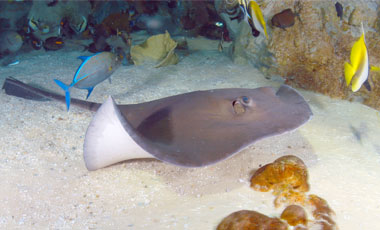
Whiptail rays sometimes travel loosely in groups – separated by size and sex – and can often be seen partially submerged in the sand at depths of up to 200 feet. In order to eat, these rays will stir up the sandy substrate with their pectoral fins to dislodge their prey. They have a relatively long life span and grow slowly, so there is growing concern for their population numbers as they are being overfished in some parts of the world.
- Max Size: 1.2-1.5 m wide; 1.2 m long; 45.4 kg
- Diet: Mostly crustaceans, fish, mussels and worms.
- Conservation Status: Vulnerable (in some areas)
- Major Threats to Survival: Vulnerable to overfishing.
- UWW Fun Facts: Female whiptail rays are slightly larger than the males when they reach maturity.
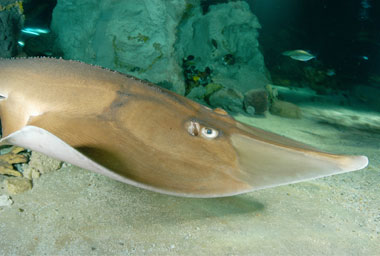
Guitarfish have been around for over 100 million years and have remained virtually unchanged! They are an ancient ray related to sharks. In fact, the genus (Rhinobatus) is a combination of Greek and Latin word parts, with “Rhine” meaning shark and “baits” meaning ray. These fish, with their flattened guitar-shaped bodies, are attuned to life on the sand. Guitarfish use special openings, called spiracles, on the top of their head to bring in water and pump it over their gills; otherwise they would get a mouth full of sand.
- Max Size: 1.7 m (5.5 ft)
- Diet: Feeds on mollusks, crustaceans and small fish that can be sucked out of the sand.
- Conservation Status: Threatened
- Major Threats to Survival: Vulnerable to overfishing.
- UWW Fun Facts: The Shovelnose Guitarfish matures at around 7-8 years and gives birth to live young. Ours are from Australia.

Camouflaged like a rock, this stealthy ambush predator will sit on the bottom and wait for unwary prey to swim by. Their dorsal (top) surface is equipped with venomous spines, which cause an intense pain and can be fatal if the victim does not receive medical attention within a couple of hours. The first response to a stonefish encounter is to immediately immobilize the affected area and apply heat or hot water. This will break down the proteins in the venom.
- Max Size: 40 cm
- Diet: Fish and crustaceans
- Conservation Status: Not evaluated
- Major Threats to Survival: Minor collections for aquarium trade
- UWW Fun Facts: Stonefish are the most venomous fish in the world
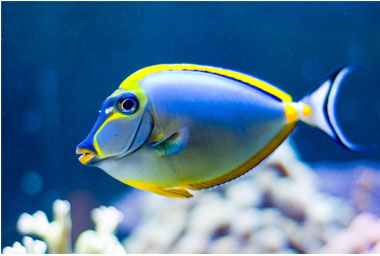
This spectacular species of surgeonfish is equipped with formidable weaponry. Their name alludes to the razor-sharp, keel-like spines located on both sides of the body near the tail. These spines are capable of inflicting a deep and painful wound. Orangespine surgeonfish are usually found in small aggregations that spend the better part of the day grazing on algae or zooplankton and shelter within the coral reef at night.
- Max Size: 46 cm
- Diet: Primarily feeds on leafy brown algae
- Conservation Status: Not evaluated
- Major Threats to Survival: Minor collections for aquarium trade.
- UWW Fun Facts: Orangespine surgeonfish and many other species of surgeonfish are important food fish on most tropical islands.
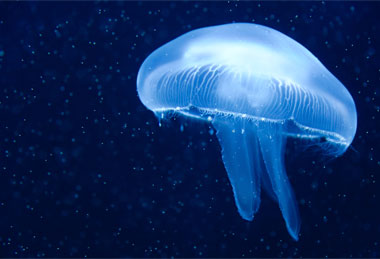
Sea jellies belong to the phylum Cnidaria, which also includes sea anemones and coral. Members of this phylum have characteristic stinging cells, called cnidocytes, located in their tentacles that are used to trap and subdue prey. The venom toxicity of different species of sea jellies ranges from barely noticeable to extremely deadly.
Sea jellies have limited control over movement and spend much of their lives drifting at the mercy of ocean currents. They can swim by contracting and relaxing a muscle in their bell, a form of jet propulsion.
Moon jellies (Aurelia aurita) are a widely distributed species of sea jelly with relatively short tentacles. They are suspension feeders, so rather than trap prey with their tentacles they catch the majority of their food in the mucus coating on the inside of their umbrella and use four oral arms to move the food to their mouth.
- Max Size: 40 cm in diameter
- Diet: A variety of zooplankton
- Conservation Status: Not evaluated
- Major Threats to Survival: Not evaluated
- UWW Fun Facts: The box jellyfish (Chironex fleckeri) is said to be the most venomous animal on the planet.
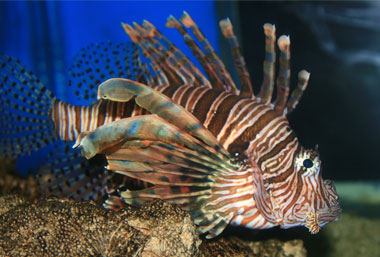
Lionfish belong to the same family as the stonefish (family Scorpaenidae) and possess venom in sacs at the base of their spines. The sting of a lionfish is said to be just as painful as that of a stonefish, however, the venom of lionfish is not normally fatal to humans. Lionfish are aggressive predators and will corner their prey using their large fins and swallow them whole.
- Max Size: 38 cm
- Diet: Small fish, shrimp and crabs
- Conservation Status: Not evaluated
- Major Threats to Survival: Not evaluated; popular in the aquarium trade
- UWW Fun Facts: Using their widespread pectoral fins to trap prey into a corner, Lionfish stun it and then swallow it in one quick movement.

If threatened, these porcupinefish will gulp water into a specialized chamber near the stomach to inflate themselves to nearly five times their normal size. Porcupinefish take their name from the prominent spines covering their bodies. These spines stand erect when the fish is inflated. An inflated adult porcupinefish is an impenetrable fortress capable of choking a large shark or giant grouper to death! Porcupinefish are only dangerous to humans when eaten, but a single fish can contain enough poison to kill 30 people!
- Max Size: 60 cm
- Diet: Hard-shelled invertebrates, primarily sea urchins, gastropods (snails) and hermit crabs.
- Conservation Status: Not evaluated
- Major Threats to Survival: Over harvesting due to low reproductive rate and slow growth. Because of their great defenses, porcupinefish have few natural predators. However, tiger sharks prey upon adults, while mahi mahi and billfishes often eat juveniles.
- UWW Fun Facts: Experienced chefs in Japan are able to prepare the nonpoisonous parts of this fish as a delicacy, called Fugu.

This giant creature is the largest bony fish found in coral reefs! They are solitary and typically take up residence in a wreck or cave in the shallow waters of lagoons and reefs. Giant groupers never venture far from home. Because they are protogynous hermaphrodites, groupers start out life as females, and later change sex to become males.
- Max Size: 2.7 m (9 ft); 400 kg (880 lb)
- Diet:Spiny lobsters, fishes, small sea turtles and even small sharks by swallowing them whole.
- Conservation Status: Vulnerable
- Major Threats to Survival: Groupers are often targeted by spear fishermen, despite the high levels of toxin (known as ciguatera) sometimes found in their meat. Juveniles are increasingly hard to find and there is little chance of large groupers reappearing in unprotected areas due to their slow growth rate and late maturity.
- UWW Fun Facts: We have two giant groupers from Australia in the tunnel aquarium. Lyle is our biggest fish at approximately 227 kg (500 lb)!
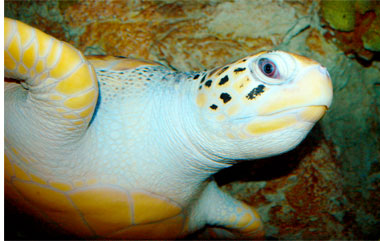
Green sea turtles get their name from the green color of their body fat. This green coloration results from the pigments absorbed from the food that they eat. Sea turtles are air-breathing reptiles that spend their lives at sea and will travel thousands of miles between feeding and nesting grounds.
Females return to the beaches where they were born to haul out and lay eggs on land, however only 1 in a 1,000 hatchlings will actually survive to breed. Sea turtle shells are streamlined and hydrodynamic, which allows them to move efficiently and gracefully in the water.
- Max Size: 40+ in.; 500 lb.
- Diet: One of the largest grazing marine herbivores, adult green sea turtles eat sea grass and algae all day long. Young green sea turtles also eat a variety of small crustaceans. At UnderWater World, our turtles eat green peppers, brussel sprouts, cabbage and romaine lettuce.
- Conservation Status: Endangered
- Major Threats to Survival: Humans are one of the greatest threats contributing to dangers such as entanglement in lost fishing gear, garbage on beaches and in the water, habitat modification and illegal harvesting of eggs/turtles. The turtles are also vulnerable to natural predation and disease. Remarkably, artificial lighting also impacts sea turtle populations by confusing new hatchlings trying to find their way to the ocean.
- UWW Fun Facts: Our green sea turtles, Napu and Scooby, arrived at UWW in 2002 from Singapore where they were rescued from the pet trade. They are each a whopping 300 lb.
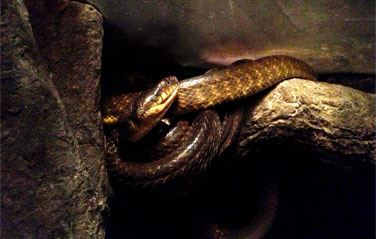
Known to be the invasive species responsible for the decline of Guam’s bird populations, the Brown Tree Snake does not typically harm humans. However, it can strike aggressively by launching into a series of s-shaped loops when threatened. In addition to being poisonous, they are constrictors, which means that they can kill by wrapping themselves around their prey and squeezing.
- Max Size: 3 m (9.8 ft)
- Diet: Birds, eggs, lizards and small mammals
- Conservation Status: Low Priority
- Major Threats to Survival: Population decline may be linked to depleted food sources, adult mortality and/or suppressed reproduction
- UWW Fun Facts: Often mistaken as a native creature of Guam, the venomous Brown Tree Snake likely made its way to the island via ship cargo.
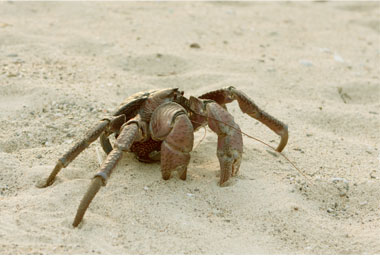
Not only is the Coconut Crab the largest terrestrial arthropod in the world, it can climb trees up to 20 feet high just to reach growing coconuts. Using its two powerful front chelipeds, it can easily tear through the tough husk of a coconut to feed on the flesh. There are currently several measures in place to protect the crabs — for example, only crabs of a certain size can be collected, and it’s illegal to catch any crab carrying eggs.
- Max Size: Leg span over 3 ft; 9 lbs
- Diet: Mainly scavengers, they feed on coconuts and other tropical fruits
- Conservation Status: Data Deficient
- Major Threats to Survival: Human predation and habitat disruption
- UWW Fun Facts: During World War II, the clever coconut crabs earned a reputation for stealing items from the trenches of American marines.








